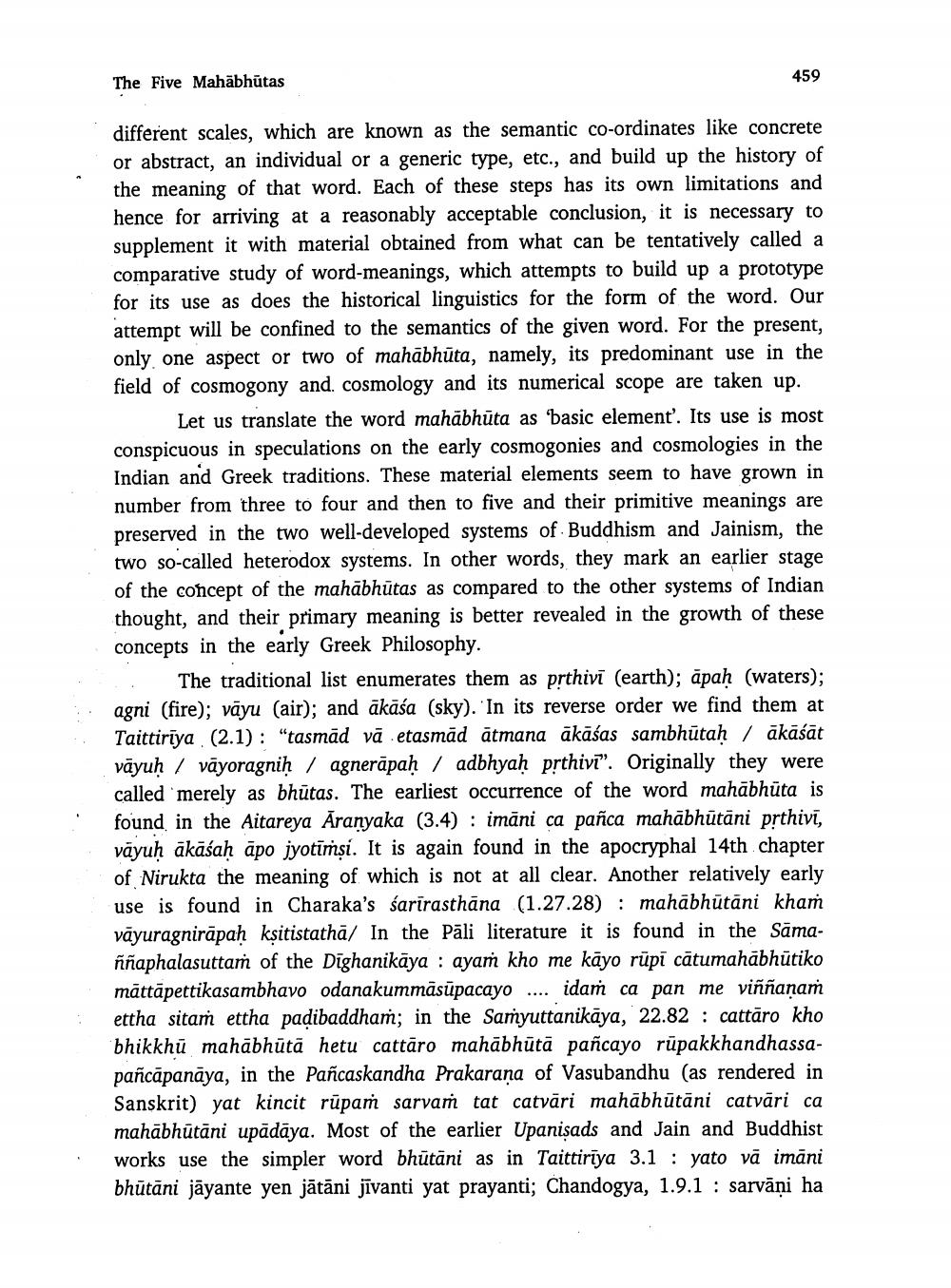________________
The Five Mahābhūtas
459
different scales, which are known as the semantic co-ordinates like concrete or abstract, an individual or a generic type, etc., and build up the history of the meaning of that word. Each of these steps has its own limitations and hence for arriving at a reasonably acceptable conclusion, it is necessary to supplement it with material obtained from what can be tentatively called a comparative study of word-meanings, which attempts to build up a prototype for its use as does the historical linguistics for the form of the word. Our attempt will be confined to the semantics of the given word. For the present, only one aspect or two of mahābhūta, namely, its predominant use in the field of cosmogony and cosmology and its numerical scope are taken up.
Let us translate the word mahābhūta as 'basic element. Its use is most conspicuous in speculations on the early cosmogonies and cosmologies in the Indian and Greek traditions. These material elements seem to have grown in number from three to four and then to five and their primitive meanings are preserved in the two well-developed systems of Buddhism and Jainism, the two so-called heterodox systems. In other words, they mark an earlier stage of the concept of the mahābhūtas as compared to the other systems of Indian thought, and their primary meaning is better revealed in the growth of these concepts in the early Greek Philosophy.
. The traditional list enumerates them as prthivi (earth); āpaḥ (waters); agni (fire); vayu (air); and ākāśa (sky). In its reverse order we find them at Taittiriya (2.1): "tasmad vā etasmād ātmana ākāśas sambhūtaḥ, ākāśāt vāyuh / vāyoragnih / agnerāpah / adbhyaḥ prthivi". Originally they were called merely as bhūtas. The earliest occurrence of the word mahābhūta is found in the Aitareya Aranyaka (3.4) : imāni ca pañca mahābhūtāni prthivi, vayuh ākāśah apo jyotims. It is again found in the apocryphal 14th chapter of Nirukta the meaning of which is not at all clear. Another relatively early use is found in Charaka's śarīrasthāna (1.27.28) : mahābhūtāni kham vāyuragnirāpah ksitistathā/ In the Pāli literature it is found in the Samaññaphalasuttar of the Dighanikāya : ayam kho me kāyo rūpi cātumahābhūtiko mättäpettikasambhavo odanakummāsūpacayo .... idam ca pan me viññanam ettha sitam ettha padibaddham; in the Samyuttanikāya, 22.82 : cattāro kho bhikkhū mahābhūtā hetu cattāro mahābhūtā pañcayo rūpakkhandhassapañcāpanāya, in the Pañcaskandha Prakarana of Vasubandhu (as rendered in Sanskrit) yat kincit rūpaṁ sarvam tat catvāri mahābhūtāni catvāri ca mahābhūtāni upādāya. Most of the earlier Upanisads and Jain and Buddhist works use the simpler word bhūtāni as in Taittirīya 3.1 : yato vā imani bhūtāni jāyante yen jātāni jīvanti yat prayanti; Chandogya, 1.9.1 : sarvāṇi ha
..




